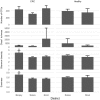Preliminary Comparison of Oral and Intestinal Human Microbiota in Patients with Colorectal Cancer: A Pilot Study
- PMID: 29375539
- PMCID: PMC5770402
- DOI: 10.3389/fmicb.2017.02699
Preliminary Comparison of Oral and Intestinal Human Microbiota in Patients with Colorectal Cancer: A Pilot Study
Abstract
In this study Next-Generation Sequencing (NGS) was used to analyze and compare human microbiota from three different compartments, i.e., saliva, feces, and cancer tissue (CT), of a selected cohort of 10 Italian patients with colorectal cancer (CRC) vs. 10 healthy controls (saliva and feces). Furthermore, the Fusobacterium nucleatum abundance in the same body site was investigated through real-time quantitative polymerase chain reaction (qPCR) to assess the association with CRC. Differences in bacterial composition, F. nucleatum abundance in healthy controls vs. CRC patients, and the association of F. nucleatum with clinical parameters were observed. Taxonomic analysis based on 16S rRNA gene, revealed the presence of three main bacterial phyla, which includes about 80% of reads: Firmicutes (39.18%), Bacteroidetes (30.36%), and Proteobacteria (10.65%). The results highlighted the presence of different bacterial compositions; in particular, the fecal samples of CRC patients seemed to be enriched with Bacteroidetes, whereas in the fecal samples of healthy controls Firmicutes were one of the major phyla detected though these differences were not statistically significant. The CT samples showed the highest alpha diversity values. These results emphasize a different taxonomic composition of feces from CRC compared to healthy controls. Despite the low number of samples included in the study, these results suggest the importance of microbiota in the CRC progression and could pave the way to the development of therapeutic interventions and novel microbial-related diagnostic tools in CRC patients.
Keywords: Fusobacterium nucleatum; colorectal cancer; gut microbiota; oral microbiota; quantitative polymerase chain reaction; taxonomic analysis.
Figures







Similar articles
-
Detection of colorectal-cancer-associated bacterial taxa in fecal samples using next-generation sequencing and 19 newly established qPCR assays.Mol Oncol. 2025 Feb;19(2):412-429. doi: 10.1002/1878-0261.13700. Epub 2024 Jul 6. Mol Oncol. 2025. PMID: 38970464 Free PMC article.
-
Salivary and fecal microbiota: potential new biomarkers for early screening of colorectal polyps.Front Microbiol. 2023 Aug 16;14:1182346. doi: 10.3389/fmicb.2023.1182346. eCollection 2023. Front Microbiol. 2023. PMID: 37655344 Free PMC article.
-
Detection and comparison of tumor cell-associated microbiota from different compartments of colorectal cancer.Front Oncol. 2024 May 21;14:1374769. doi: 10.3389/fonc.2024.1374769. eCollection 2024. Front Oncol. 2024. PMID: 38835371 Free PMC article.
-
Fusobacterium nucleatum Acts as a Pro-carcinogenic Bacterium in Colorectal Cancer: From Association to Causality.Front Cell Dev Biol. 2021 Aug 20;9:710165. doi: 10.3389/fcell.2021.710165. eCollection 2021. Front Cell Dev Biol. 2021. PMID: 34490259 Free PMC article. Review.
-
Impact of microbiota in colorectal carcinogenesis: lessons from experimental models.Intest Res. 2018 Jul;16(3):346-357. doi: 10.5217/ir.2018.16.3.346. Epub 2018 Jul 27. Intest Res. 2018. PMID: 30090033 Free PMC article. Review.
Cited by
-
Role of diet and gut microbiota on colorectal cancer immunomodulation.World J Gastroenterol. 2019 Jan 14;25(2):151-162. doi: 10.3748/wjg.v25.i2.151. World J Gastroenterol. 2019. PMID: 30670906 Free PMC article. Review.
-
Gut mucosal microbiota profiles linked to colorectal cancer recurrence.World J Gastroenterol. 2022 May 14;28(18):1946-1964. doi: 10.3748/wjg.v28.i18.1946. World J Gastroenterol. 2022. PMID: 35664963 Free PMC article.
-
Gut and oral microbial compositional differences in women with breast cancer, women with ductal carcinoma in situ, and healthy women.mSystems. 2024 Nov 19;9(11):e0123724. doi: 10.1128/msystems.01237-24. Epub 2024 Oct 29. mSystems. 2024. PMID: 39470189 Free PMC article.
-
Exploring the food-gut axis in immunotherapy response of cancer patients.World J Gastroenterol. 2020 Sep 7;26(33):4919-4932. doi: 10.3748/wjg.v26.i33.4919. World J Gastroenterol. 2020. PMID: 32952339 Free PMC article. Review.
-
Hydrogen Sulfide Effects on the Survival of Lactobacilli with Emphasis on the Development of Inflammatory Bowel Diseases.Biomolecules. 2019 Nov 20;9(12):752. doi: 10.3390/biom9120752. Biomolecules. 2019. PMID: 31756903 Free PMC article.
References
LinkOut - more resources
Full Text Sources
Other Literature Sources
Molecular Biology Databases

